How To Oil A Bike Chain? If your bike has a chain, it will need to be oiled from time to time. Oiling a bike chain is a relatively simple process, and only takes a few minutes. You will need a rag and some bicycle chain oil.
First, find the spot on the chain where the oil will go. Then, put a small amount of oil on the rag and rub it onto the chain. Be sure to get all the links of the chain, and avoid getting any oil on the wheels or frame of your bike. Let’s dive into our post to know how to lube a bike chain.
Why Should I Clean My Bicycle Chain?
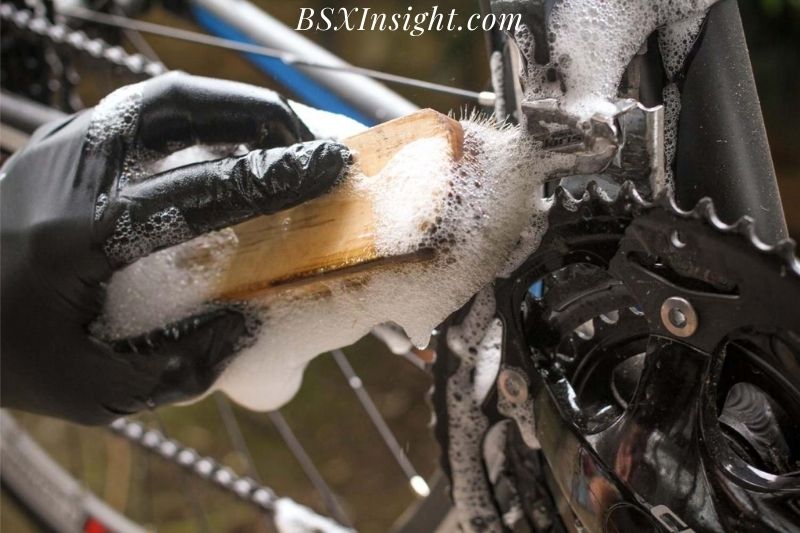
According to independent testing facility Friction Facts’ Jason Smith, a dirty chain results in a demonstrable loss of efficiency.
“The statistics can vary depending on how ‘dirty’ the chain is, but on average, testing reveals a dirty road chain will lower efficiency by roughly 3 to 5 watts (at 250-watt rider output) – about 2% of power loss,” he explains.
A properly maintained and lubricated chain, for instance, uses roughly 7 watts. A few “clean” road rides can result in an additional 3 watts of frictional losses due to light road grit.
This amount rises with grit, according to Smith, who says that riding multiple road rides without cleaning or relubricating can result in losses of roughly 5 watts. We’ve observed muddy chains provide an additional 12 watts of losses over baseline in extreme situations (MTB or cyclocross, for example).
“The sliding surfaces of each chain link experience increased friction when a chain is not properly cleaned and lubricated. The chain snakes through the drivetrain at 95 pm with a 53t front ring, resulting in 40,280 chain link articulations per minute (an articulation is when a link bends into or out of a ring, cog, or pulley). The friction within the links must be kept to a minimum because there are so many links that are continually articulating.
How To Oil A Bike Chain
Choose The Right Lube
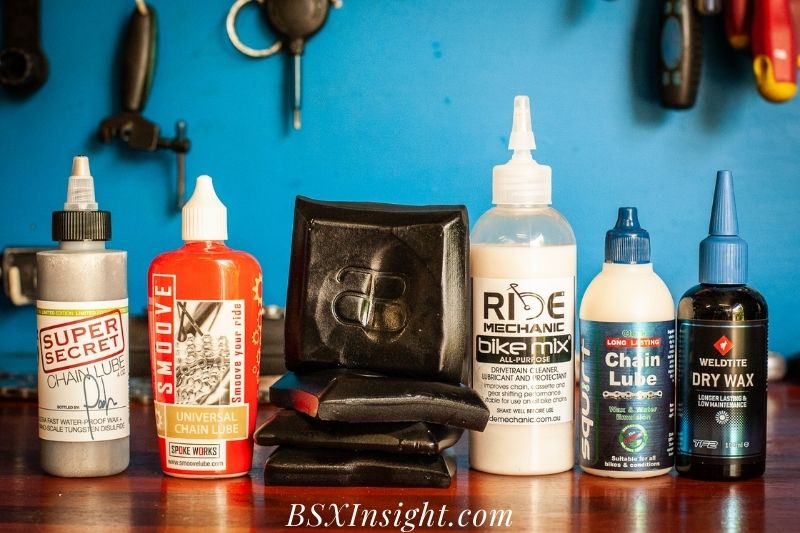
- If you want to bike in wet weather, pick a wet lube. Dry lubricant on a bike chain can be washed away by rain, snow, and slushy roads. Lube that is wet will be more resilient.
Online or in your neighborhood bike shop, you may discover a variety of bike lubes.
- If you reside in a dry climate, use a dry lube. If you’re going to be riding in dry weather, you don’t need wet lubricant because it attracts more dirt than dry lube. Dry lube will help keep your chain cleaner, but you’ll need to reapply it frequently, typically after 50–100 miles (80–161 km) of riding.
- If you ride a bike to get around, get up some wax lubrication. Wax lube is less messy than other types of bike lubrication, so whether you’re riding your bike to work or the store, it won’t get all over your clothes. Due to the fact that dirt and grit are “shed” from the wax compound, wax lube keeps your bike chain cleaner than other types of lubes.
- Avoid using WD-40 to lubricate your bike chain. Use only lubricants made especially for bicycle chains. The lubricant in WD-40, a solvent that evaporates quickly, is very little. The chain may accumulate dirt and filth as a result of this product.
Cleaning The Bicycle Chain
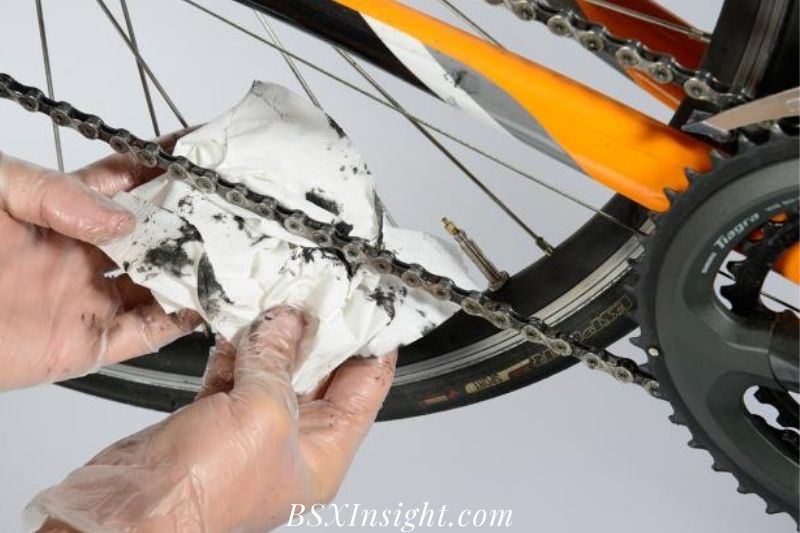
- Use an old rag to apply degreaser spray or isopropyl alcohol. Use a rag that you aren’t very attached to because the chain will make it soiled. A brief spray of degreaser or alcohol should be sufficient; neither substance needs to be used liberally.
You don’t have isopropyl alcohol or degreaser spray. You might be able to simply wipe out the bike chain you’re lubricating with a dry rag if it isn’t so nasty. You should visit your neighborhood hardware shop to pick up a degreaser spray or isopropyl alcohol if there is still filth and grime after.
- Press a portion of the bike chain with the rag. With one hand, secure the rag in place. The area of the rag where the degreaser or isopropyl alcohol was sprayed should be where the chain is touching.
- Move the chain backward until it passes through the rag. With your free hand, hold onto one of the bike’s pedals and turn the pedals backward. The bike’s chainrings should begin to rotate around the chain.
Once the entire chain has passed through the rag in your palm numerous times, keep reversing direction. As the chain rotates, keep the rag in place.
Avoid getting your fingers caught in the space between the chain and chainrings!
- For a speedy fix, use a chain scrubber. A 2-piece plastic chain scrubber is available for purchase if you don’t want to clean the chain by hand. This tool contains revolving brushes that clean the chain and a reservoir with a degreaser that clamps around the chain. Use it according to the directions on the package.
Typically, two sections are slid around the chain, a degreaser is applied to the bottom half, and the chain is then pedaled backward for ten revolutions.
- If your bike chain comes off, put it back on. Pushing the rear derailleur arm—the metal arm on the back tire—into the handlebars will give the chain some slack. Reposition the rear derailleur arm and put the chain back on the chainrings. You should be all set to go if you just pedal the chain a few times!
Ultrasonic cleaners

As far as chain cleaners go, ultrasonic cleaners will perform the best. Although it will be restored to its original condition, not everyone has an ultrasonic cleaner sitting around the house. If you opt to buy one, it won’t cost you much, and you can use it to clean both your chain and cassette sprockets.
To take apart and replace these parts, though, you’ll need some knowledge of basic bike maintenance and the right equipment. If you do get one, make sure the tank is big enough to cover the full cassette and is both wide and deep.
Every time you use it, you’ll need to refill its reservoir with a fresh degreaser, but because of its ultrasonic deep cleaning action, it works wonders in just a few minutes.
Applying The Lubrication
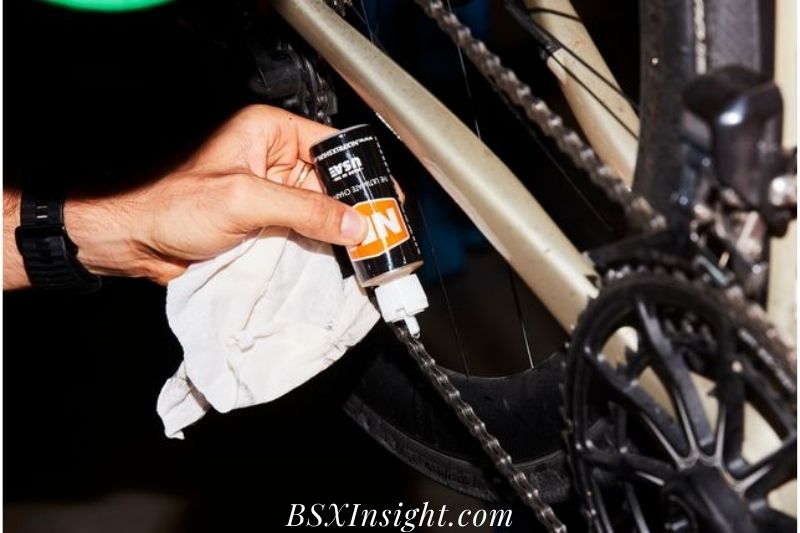
- Thoroughly shake the lubricant container. Give the lube a vigorous shake to combine all of the ingredients since they may have separated while it was sitting on the shelf.
- Apply the lube by squeezing the bottle and reversing the chain. Hold the lubricant bottle so that the chain’s interior is facing the nozzle of the bottle. To make the chain on the bike move around the chainrings, use your free hand to turn the pedals backward.
Squeeze lubrication into every portion of the chain as it passes by as you repeatedly run the chain around the chainrings. As you backpedal the chain, maintain your grip on the lubricant container.
- Put the lube aside and keep moving the chain backward. This will aid in lubricating the chain. At least ten more times with the chain on the chainrings. After that, softly change gears to distribute the oil to the chainrings and cassette gears.
- Use a towel to remove extra lubrication. Reverse the chain while holding the rag against it. Once all of the extra greases have been removed, wrap the chain several times around the chainrings and through the rag.
Do not omit this phase! Dirt and grime may accumulate on the chain as a result of too much lubricant.
Clean The Surface of The Chain of Any Extra Lube.
Although many riders omit this step, it is crucial if you want to lubricate your bike chain properly. Why is it significant? Since there is friction between the chain links, there is no need for extra lubrication to be applied to their exteriors.
Any extra product draws dirt, which over time, causes the chain’s performance to degrade. Use an old band t-shirt as your rag and carefully run the chain through it to remove any extra lubrication from the chain’s surface after letting it sit for the night.
What Should I Do If My Chain Needs To Stay On?

A chain-cleaning tool is advised by the majority of bicycle maintenance product manufacturers, including Park Tool and Muc-Off.
Here, the device has revolving brushes that controllably move the degreaser through the chain as it is backed past. Experience has shown that they all perform very similarly, and the only major difference between them is in the way they are built.
Further advocating the use of a “dummy hub” (also known as a chain keeper) in place of the rear cogs is Jones of Park Tool.
This is a popular practice among WorldTour race mechanics and is done particularly to avoid running degreaser through your freehub and rear hub bearings.
Easy access to the derailleur pulley wheels, where gunk is known to accumulate, is a secondary benefit.
Removing the wheel will also ensure that any oil-filled degreaser stays off your disc rotor if your bike has disc brakes. To go one step further, you can seal your brake caliper using a plastic bag and an elastic band. Read more about how to adjust bike brakes.
Follow up with a second wash in warm, soapy water after using a chain scrubber and a degreaser. Any remaining grit is flushed out using two different solvents, advises Jones.
Smith of Friction Facts concurs with Jones and Sampson that the ideal solution, if the chain must remain on, is to use chain-cleaning equipment. However, he cautions of possible issues when doing so: The chain cannot be immersed in the cleaning solution first.
Another important consideration is the chain’s tension, says Smith: “The positive tension prevents the chain from becoming slack even though the tension [provided by the rear derailleur cage spring] is light. A chain that is relaxed allows the cleaner to move through the internals more easily than one that is tight.
It’s preferable to do it outside, whether you’re using a stiff-bristled brush, a chain cleaning tool, or the tacky sweater you got for Christmas. Chain cleaning is a filthy activity; it is not recommended to do it over the carpet or indoor floors.
Diesel, benzene, gasoline, and acetone are among the dangerous degreasers Jones advises against using. There are many solutions that are safer and healthier and will thoroughly clean your chain.
A power washer can also take the grease from your bearings if you point it in the wrong way, so resist the urge to use one as a chain cleaner “unless you are ready to overhaul the bike at the same time,” advises Jones.
Watch this video to follow the process easily
Should You Take Your Chain Off Your Bike To Clean It?
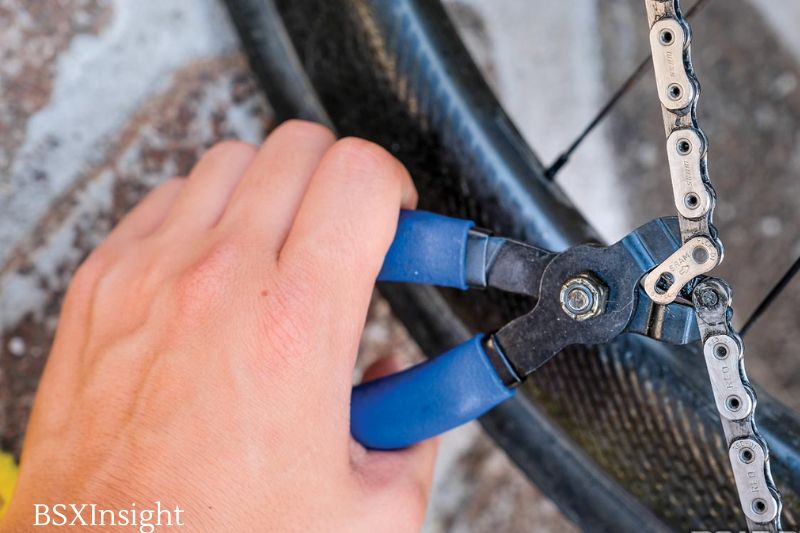
It’s a good idea to clean your bike chain regularly, and taking it off to do so is the best way to ensure you get a thorough cleaning.
It’s not a difficult process, and you can find chain-cleaning devices at most bike stores.
You’ll need to remove the chain from the bike and then soak it in a degreaser or solvent for a few minutes before scrubbing it with a brush. Once it’s clean, rinse it off with water and dry it before putting it back on the bike.
Issues to Watch for When Cleaning
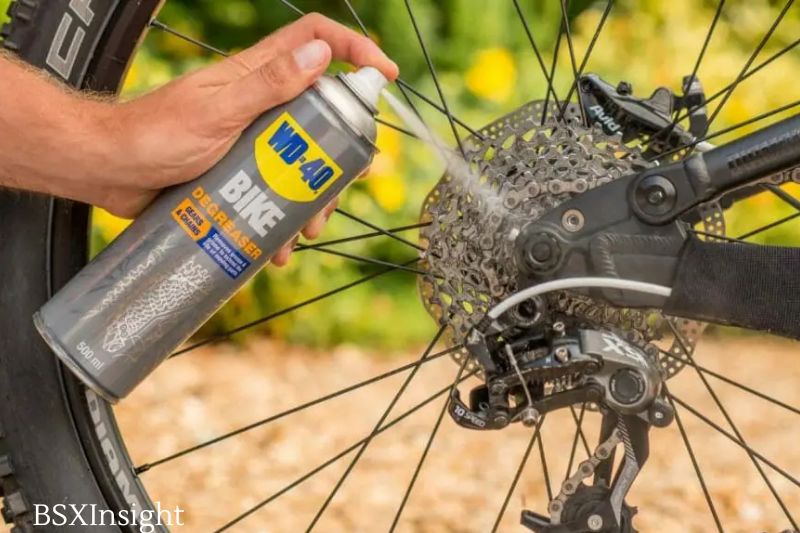
Tight Links
One of the most common problems people run into when cleaning is tight links. This can be a problem with both hand-washing and machine-washing.
When links are tight, it can be difficult to get them completely clean. In addition, tight links can also cause clothing to stretch and become misshapen.
To avoid this problem, be sure to check the manufacturer’s care instructions before washing. If possible, loosen the links before washing. In addition, be sure to use a gentle cycle and avoid overloading the washing machine.
Chain Stretch
When you are cleaning your chain, you need to be aware of the potential for chain stretch. This is when the links in your chain start to wear down and become longer. This can cause your chain to skip or jump, and it can also make it difficult to shift gears. If you notice your chain starting to stretch, you should have it replaced as soon as possible.
Can a Chain be Too Clean?
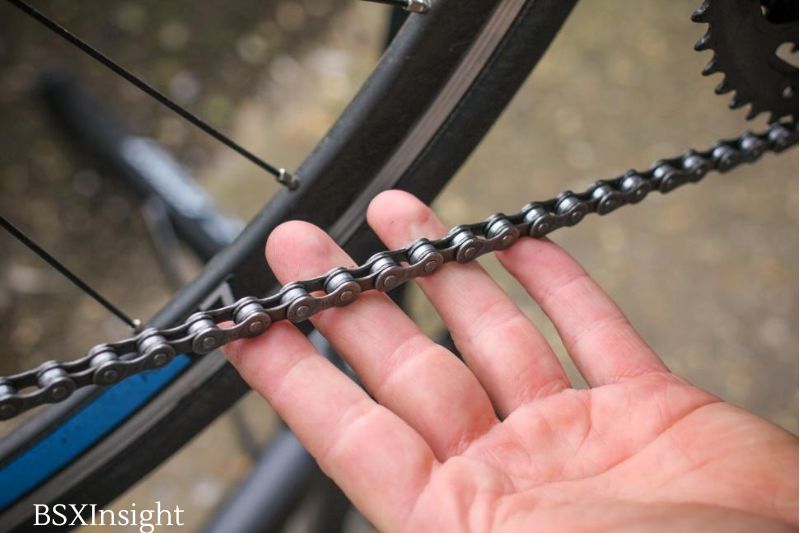
A chain can be too clean if it is not properly lubricated. A clean chain will cause more friction and wear on the drivetrain components, which can lead to premature wear.
It is important to clean your chain regularly, but you should also lubricate it after cleaning to protect the chain from excessive wear.
FAQs
Can I use WD-40 on my bike chain?
Only use lubricants designed specifically for use on bike chains. WD-40 is a solvent that evaporates quickly and only contains a small amount of lubricant. This product can cause dirt and grime to build up on the chain.
How often should you oil your bike chain?
How often should you clean and lube your chain? A good rule of thumb is once a week if you ride daily, and it’s a must after you ride in the rain or anywhere that’s very muddy. And if you hear what sounds like your bike chirping at you as you ride, that’s your chain crying out for attention!
What is a Music-Off eBike Dry Chain Cleaner?
The majority of bicycle maintenance product brands, including Park Tool and Muc-Off, recommend the use of a chain-cleaning device.
How to lube a bike chain without a stand?
Lube It: Soak a clean rag with a degreaser, such as With your bike in a work stand, grasp the chain with the rag as you backpedal to remove grime from the rollers and side plates. Repeat until the chain is clean. Then, dry the chain using a clean rag and the same technique you used to clean it.
What is a Music-Off All-Weather Chain Lube?
4 Wipe off excess lube with a rag. Hold the rag against the chain and backpedal the chain. Run the chain around the chainrings and through the rag a few times until all the excess lube is off. Don’t skip this step!
Conclusion
In summary, to oil a bike chain, start by applying oil to the inside of the chain. Then, use a rag to wipe off any excess oil. Next, apply oil to the outside of the chain, and use a brush to spread it evenly. Finally, use a clean rag to wipe off any excess oil.
We hope that this article can help you know how to lubricate a bike chain properly. Thanks for reading!

